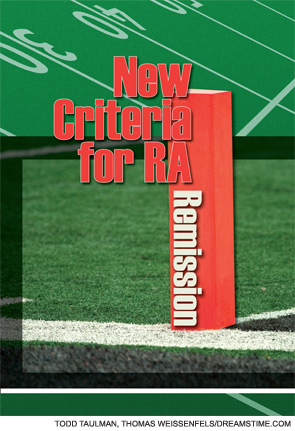
The ACR and the European League Against Rheumatism (EULAR), in cooperation with members of the Outcome Measures in Rheumatology (OMERACT) initiative, have completed the first comprehensive provisional definition of remission in rheumatoid arthritis (RA) for clinical trials since 1981.1 The criteria are designed to distinguish true remission from even minimal disease activity. They provide clear endpoints for clinical trials as well as treatment goals that rheumatologists and their patients can pursue. The new criteria will enable doctors to better evaluate patients’ conditions, as well as patients’ prospects for achieving remission or, alternatively, for achieving minimal disease activity.
Reasons for the Update
One key reason that old criteria needed updating is that they were very stringent; treatments were so much less effective in the 1980s that very few patients could meet the criteria for remission. Additionally, the old definition contained elements not in the core set of disease activity measures, such as morning stiffness and swelling in tendon sheaths. These problems led to development of many modifications of the criteria by various interested parties, which created considerable confusion in the field, says Maarten Boers, MD, PhD, professor of clinical epidemiology and biostatistics at VU University Medical Center in Amsterdam, the Netherlands, and a coauthor of the new criteria.
Moreover, the old definitions of remission frequently had problems. By one of the most popular sets of criteria, which uses the Disease Activity Score (DAS), a patient could be categorized as “in remission” and yet have substantial residual disease activity in joints that are included in that score, says Dr. Boers.
This did not matter much to those in clinical practice, however, because patients so rarely achieved remission by any definition, points out David Felson, MD, MPH, professor of medicine and epidemiology at Boston University School of Medicine, and a coauthor of the new criteria.
Indeed, in the U.S. and Western Europe in the early 1980s, the prospects for patients were similar to what currently prevails in lower-income countries today, “where you can see the types of disease activity that my generation of rheumatologists grew up with,” says Dr. Boers. At that time, patients “were walking around with six to 10 swollen and 15 to 20 painful joints. We gave them gold, put them in clinics, and the joints were slowly destroyed,” he says.
But now, “with the advent of new therapies and therapeutic strategies … remission has become a realistic goal, and has recently become a secondary or even primary endpoint for clinical studies and trials,” according to the “ACR/EULAR Provisional Definition of Remission in RA for Clinical Trials.” The definition points out that “remission is also regarded as a major therapeutic target in clinical practice and can be achieved in a significant proportion of patients followed in routine care.”
The new criteria are designed to provide information that can be used in clinical trials, as well as a goal towards which rheumatologists and their patients can aspire.
Remission Defined
The committee overseeing the development of the new criteria—which included members of the ACR, EULAR, and OMERACT—specified that the definition should be stringent, with little, if any, active disease. A key goal was for the criteria to predict good X-ray and functional outcomes. To achieve that end, the committee compared candidate definitions with clinical trial data.
The committee actually came up with two definitions for RA remission, “but we ask in the paper that one be selected in advance for any study and that both be reported,” says Dr. Felson, adding that the two definitions are “very similar to each other.” One definition specifies that scores be less than or equal to 1 for tender joint count, swollen joint count (both using the 28-joint count), C-reactive protein (in mg/dL), and patient global assessment (0–10 scale). “As rheumatoid arthritis often targets the feet, we recommend doing full joint counts; however, we also found that limited [28] joint counts can perform acceptably in trials,” says Dr. Boers.
The second definition is a score of 3.3 or less on the simple disease activity index (SDAI) for RA. The SDAI includes tender and swollen joint count (based on a 28-joint assessment), patient and physician global assessment of disease activity on a scale of 1–10, and C-reactive protein (mg/dL).
The committee came up with two definitions for RA remission, but we ask in the paper that one be selected in advance for any study and that both be reported.
—David Felson, MD, MPH
Limitations of the New Criteria
While the new criteria do set a standard definition of RA remission that can be widely applied to clinical trials, they do have some limitations and highlight areas where more research and data are needed.
For example, patient groups, including the patient perspective group within OMERACT, and other stakeholders have emphasized the importance of fatigue as an outcome and have recommended that it be reported in clinical trials. However, there were no data on fatigue that could have shown how it would perform as part of the criteria, Dr. Boers says. Therefore, fatigue was not used to derive the remission criteria. “Other measures patients feel are important include sleep quality, which currently is imperfectly measured.” Dr. Boers emphasizes that such measures may become very informative in the near term.
Dr. Boers also predicts that new criteria might be further refined by new imaging modalities. He explains that the criteria are limited by incomplete knowledge. “As long as we don’t have a full understanding of the pathophysiology or one key biomarker that shows us when the disease is on or off, [the criteria represent] an indirect measure of a disease process we comprehend incompletely,” he says.
Even all that notwithstanding, Dr. Boers says that the new definition will remain preliminary until the exercise that the committee did formulating and validating it can be repeated in another dataset.
Meanwhile, “it would be good if researchers of currently ongoing clinical trials would calculate the remission rates using the new definition for purposes of information, even if they were not included in the study at the outset,” says Josef Smolen, MD, chair of rheumatology at the University of Vienna in Austria. “Also, retrospective analysis of published trial data could provide important information on the frequency of stringent remission for particular therapies.”
Implications
The new criteria provide a clear target for therapy, one that the physician can determine with simple calculations. Whereas one of the commonly used old definitions of remission allowed a patient to have 30% residual activity and still be in remission, now “words mean what they mean,” says Dr. Boers. “What we used to call ‘remission’ is now ‘minimal disease activity’.”
As Dr. Smolen explains, “remission is now clearly the goal of treatment, and rheumatologists need to aim for a total lack of inflammatory disease activity. If the patient doesn’t achieve remission, the rheumatologist should strive to understand why, and work with the patient to adapt therapy accordingly.”
For example, if the patient is doing well on methotrexate but still has active disease, the rheumatologist can discuss with the patient the possibility of trying additional medications to pursue remission. “That conversation happens all the time, anyway, but the new definitions provide a more stringent target,” says Dr. Felson.
Of course, a patient with minimal disease activity “may be satisfied with where they are, and reluctant to be treated with other drugs that have risks, and that’s very reasonable,” says Dr. Felson. However, if the patient fails to reach the definition of remission, “there is a risk—and not a small risk—of joint damage, which over the long term means irreversible disability,” says Dr. Smolen. The new criteria enable the rheumatologist to give a better estimate of the likelihood that the patient’s disease could be put into remission, and give the patient a clearer picture of the pros and cons of treatment decisions.
Insurance
Unfortunately, side effects of therapies are not the only thing that must be considered. “Most patients are doing really well, and can reach a state of minimal disease activity, which we used to call ‘remission,’ ” says Dr. Boers. “As most of the current drugs are extremely expensive, we should make sure that the new, more ambitious target of real remission is not used to deny coverage for such drugs, as this target cannot be reached by the majority of patients.”
Commenting on whether the new criteria will have any effect on insurance coverage in the U.S., either now or following full implementation of healthcare reform, Dr. Felson says he does not know and does not want to speculate.
Under the new criteria, up to 20% of patients in clinical trials and clinical practice are achieving remission, says Dr. Smolen. However, 30–50% of patients seen by rheumatologists have moderate to high disease activity. For these patients, especially, the new criteria provide an important goal—and the means of mapping the pathway to achieving it.
David Holzman is a freelance journalist based in Massachusetts.

